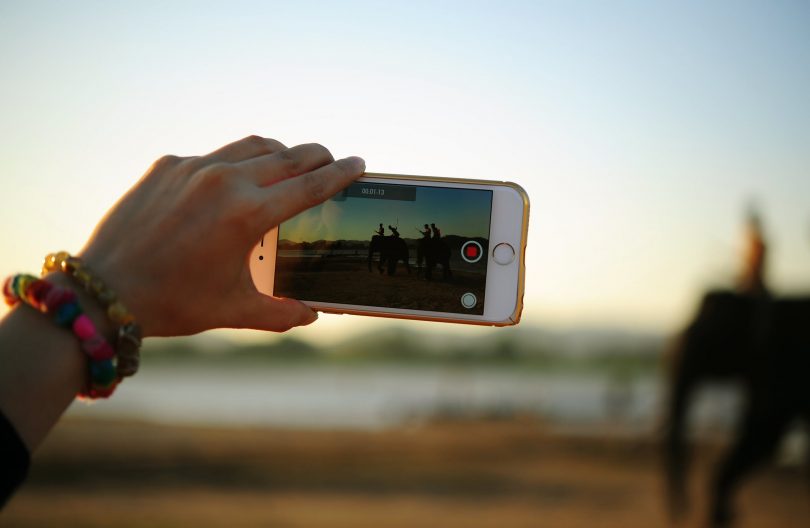Contents
Goodbye text and photos, there is a new way that Internet users want to consume information and media; video. Internet users are consuming more video content than ever before, and video now composes around 70% of all internet traffic.
On Facebook, videos have 8 billion views a day, and receive 135% more organic reach than any other form of social content. This is largely because of the rise of smartphone adoption. 93% of video watchers on Twitter do it on their phones, and smartphone users are 1.5 times more likely to watch a video on Facebook.
On Instagram, the time spent watching videos has increased 80% every year.
The astounding popularity of video on social media has led Instagram to recently announcing that they will be bringing out a new app, called IGTV. IGTV offers an incredible opportunity for small businesses to massively increase their reach on social media. To start, there will be less competition on IGTV, meaning that your small business could really make its mark on the platform.
Most small businesses already know the importance of having a social media presence, but many are still lagging behind when it comes to producing enough video content to satisfy their video loving audiences on social media, 55% of which watch online videos every single day. Larger companies have started to produce around 18 videos a month, which used to be the average blog publishing schedule.
If your blog is starting to look a bit stale, and isn’t generating the kind of conversions and leads you were hoping for, then you might want to consider switching your efforts to making a ‘vlog’, and using videos instead of just plain text and photos.
According to the Aberdeen Group, video blogging could garner 66% more qualified leads annually. Sharing a vlog on social media will also be far more popular than sharing a blog post, and could get you 400% more engagement, according to Facebook.
Here are a few marketing strategies to help your small business optimise social media content for video
1) Tailor Your Videos for the social media channel’s audience
Many people fail to fully optimise their social media video marketing strategy by thinking that they can post the same description about their video with the same hashtags to all their social media channels.
This is not the case, as each platform has a very different audience and different expectations for posting. For example, Instagrammers are more likely to be Millennials, aged 18-29 years old, and they love hashtags. So you can put multiple ones on your post. However, the same is not true for Facebook and Twitter, where the older user base dislike seeing more than two hashtags.
Twitter users respond best to videos about breaking news, and Facebook users prefer more informational content, whereas on Instagram the audience is satisfied with just being entertained.
You may even wish to create separate edits of your videos for each specific channel in order to maximise their cross channel engagement. This is when using an all-in-one video production and editing software, such as Valoso, becomes useful, as you can use it to write and schedule your posts for each particular social media channel, quickly and easily, in one place.
2) Integrating Live Video
Everyone loves live video. In fact, audiences report an 80% preference for live video over reading a business blog, and another 82% would rather see live video on your social media channels than a text post.
Live streaming your videos on Facebook, Youtube, Instagram or Periscope offers your audience more immediacy and excitement, because it is happening right there and then.
It also makes your content seem more exclusive, by adding a sense of urgency. Live stories on Instagram are only available for 24 hours. However, you can now also choose to post your live video on your Facebook page as well, so that anyone who has missed the live event can still catch up.
Although live streaming video marketing campaigns can be a bit of effort to organise, it is much more likely that you will also achieve higher engagement with your audience. The trick is to time it right, and have all the logistics taken care of by a manager or software. It is also important to pick the right kind of content, according to Livestream, 56% of the most-watched live content is breaking news and conferences, and 43% of the most popular content is concerts and festivals.
3) Increasing Your Visibility
Videos, especially those on YouTube, are preferred by Google and promoted ahead of other content. In fact, an infographic released by Filmora reported that your small business is 53 times more likely to rank on page 1 of Google when its content is in video form.
You can even promote your Youtube content with Google’s Adwords for Video platform, called TrueView ads. These are targeted pay-per-click advertisements that appear on YouTube and link back to your YouTube channel or the specific video you want to promote. For small businesses, the most cost effective of these TrueView ads are the in-search ads, which let you can pin your video to the top of searches in YouTube, without having to employ costly YouTube SEO strategies.
The new video ad platforms available mean that adopting a video marketing strategy for social media can drastically increase your visibility online, for a very minimal cost. You can also embed YouTube videos into your Facebook status, thanks to the fact that Google also owns Facebook.
4) Using insight and analytics
You can get some limited analytics on your social media videos using the ‘insights’ tab on Facebook, Twitter and Instagram. However, it can be tricky to draw any meaningful analysis from the few statistics they show you. If your small business is really trying to optimise and refine their video marketing strategy, there is more in-depth software available on the market that can show you more information and let you break down the data in a more meaningful way.
Some video marketing software will collect and report on the data from your video’s performance on each social media platform, rather than just giving you limited insights from individual channels, which can save your small business a lot of time and money in personnel.
Using an integrated platform that collates the data from across your social media channels, provides you with valuable insight into what elements of your social media video marketing strategy is working, and what needs improving.
As it appears that internet users are rejecting the written word more than ever before, every company and brand, no matter how big or small, is scrambling to provide enough video content for them.
This new trend has made startups offering video services extremely popular with small businesses who cannot afford to hire their own full-time video teams, as the entire process of video creation can be outsourced for a fraction of the cost.
To fill this new demand for video, a new form of video marketing tech has arisen. These SaaS (software as a service) companies take care of every element of video creation, from sourcing local videographers, to organising the capture of events and social media worthy moments.







